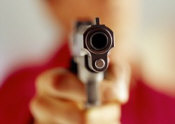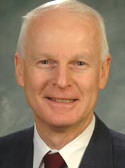What if one of the teachers had a gun?
Sandy Hook massacre begs question of how to protect children at school
by Drew Zahn -- Email | Archive
Article source
Does making schools "gun-free zones" really protect children, or make them easy targets?
 The
recent mass shooting at Sandy Hook Elementary School in Newtown, Conn.,
has left many wondering how best to keep children safe from mad gunmen
who ignore the "gun-free zone" laws -- - and indeed any gun-control laws - -- to open fire on our nation's most innocent.
The
recent mass shooting at Sandy Hook Elementary School in Newtown, Conn.,
has left many wondering how best to keep children safe from mad gunmen
who ignore the "gun-free zone" laws -- - and indeed any gun-control laws - -- to open fire on our nation's most innocent.According to news reports of the Connecticut massacre, Adam Lanza, 20, shot his mother Nancy dead at their family home, then drove to the school, where he gunned down six more adults and 20 children, before killing himself.
But what if one of the teachers had a gun, too? Could Lanza have been stopped and many of the children's lives saved?
The question isn't new. Back in 1999, the year of the Columbine school shooting, an organization called Jews For The Preservation of Firearms Ownership interviewed Dr. David Th. Schiller, a leading gun-rights advocate in Europe on how to combat the school shootings that even then were deemed "quite common" on U.S. soil.
Schiller cited the example of Israel in the 1970s, which had suffered a string of horrific attacks on schoolchildren by Palestinian terrorists.
"After this a controversial debate erupted in Israel in regards to guns, self-defense, etc.," Schiller said. "We heard, of course, the same dumb arguments by some good people you always hear on these occasions, like, 'We do not live in the Wild West here!' or, "Guns don't solve problems!" or similar silly things."
But then, Schiller explained, Israel dumped its strict gun laws dating back to British rule over the area and opened the doors for concealed carry permits.
"Teachers and kindergarten nurses now started to carry guns, schools were protected by parents (and often grandpas) guarding them in voluntary shifts. No school group went on a hike or trip without armed guards," Schiller explained. "When the message got around to the PLO groups and a couple infiltration attempts failed, the attacks against schools ceased. Too much of a risk here: Terrorists and other evildoers don't like risks.
"The only thing we can do is protect possible victims," Schiller concluded. "And laws written in some books will not achieve that. Never have, never will."
In the U.S., the question of teachers with guns has been debated since Columbine -- if not before -- and has come up again following the tragedy at Sandy Hook.
 According
to the Associated Press, Oregon State Rep. Dennis Richardson contends
the Connecticut massacre is another "heartbreaking failure" of school
personnel to ensure protection and evidence that teachers should be
allowed to carry guns in the classroom.
According
to the Associated Press, Oregon State Rep. Dennis Richardson contends
the Connecticut massacre is another "heartbreaking failure" of school
personnel to ensure protection and evidence that teachers should be
allowed to carry guns in the classroom.Richardson wrote in an email to three southern Oregon school superintendents that gun bans on school property must be overturned.
"If I had been a teacher or the principal at the Sandy Hook Elementary School, and if the school district did not preclude me from having access to a firearm, either by concealed carry or locked in my desk, most of the murdered children would still be alive, and the gunman would still be dead, and not by suicide," he wrote.
Richardson added, "We need to ensure that our children are safe, and we can't do that by disarming those who are on the scene."
In Medford, Ore., where the school district faced a lawsuit over barring a high school teacher from bringing her gun to school in 2009, Police Chief Tim George argued Richardson is misguided.
"Teachers don't go into teaching to be police officers, they want to teach kids," George said. "In crisis situations there are a lot of very complex things happening all at once, and you have to constantly train for deadly force incidents."
Medford's schools Superintendant Phil Long agreed, saying he believes it's best if teachers focus on getting children to safety if a shooting happens.
"I know (Richardson) is well-intentioned when he says this," Long said. "But we can't jump to conclusions immediately after a tragedy like this occurs."
Already armed
In 2008, the tiny school district in Harrold, Texas, made national news when it approved a policy change permitting employees to carry concealed firearms to deter and protect against school shootings.In order for teachers and staff to carry a pistol, the Associated Press reported at the time, they must have a Texas license to carry a concealed handgun; must be authorized to carry by the district; must receive training in crisis management and hostile situations and have to use ammunition that is designed to minimize the risk of ricochet in school halls.
Superintendent David Thweatt argued there was just too little protection for the children, when his schools lie more than 20 minutes from the nearest sheriff's office.
"When the federal government started making schools gun-free zones, that's when all of these shootings started," Thweatt told the Fort Worth Star-Telegram. "Why would you put it out there that a group of people can't defend themselves? That's like saying 'sic 'em' to a dog."
Texas law typically outlaws firearms on school campuses, "unless pursuant to the written regulations or written authorization of the institution."
Four years later, following the Connecticut shooting, the Star-Telegraph revisited Thweatt and the Harrold school district's "guardian plan."
Thweatt said there has not been an incident on his campus since implementing the policy and he doesn't expect one.
"Is that 100 percent? No," Thweatt told the newspaper. "Nothing is 100 percent. But what we do know is that we've done all we can to protect our children."
Thweatt explained his district has also installed special locks and cameras, but that isn't enough. He doesn't want a plan where you "lock yourself in your closet and hope that an intruder won't hurt you. So what we came up with was a policy that would protect."
He also said his heart was heavy after learning of the shooting in Connecticut: "It's just tearing me up ... I have children of my own. I can't stand to think of my little guys just getting slaughtered like that. My heart just bleeds for these people."
Other efforts to arm teachers
Lawmakers in a number of states in recent years have made arguments similar to Thweatt's, attempting to clear the way for trained teachers or officials to protect schools with firearms.The aforementioned Oregon, after a school shooting in 1998 -- when student Kip Kinkel killed his parents at home, then drove to Thurston High School in Springfield and opened fire in the cafeteria, killing two and wounding 25 others -- has drafted a number of bills to permit concealed carry in schools. The bills, however, have failed to pass.
After a string of school shootings in Wisconsin, Colorado and Pennsylvania in the span of only a few weeks in 2006, Wisconsin State Rep. Frank Lasee pushed for legislation that would allow teachers, principals, administrators and other school personnel to carry concealed weapons.
"To make our schools safe for our students to learn, all options should be on the table," Lasee told the AP. "Israel [has] well-trained teachers carrying weapons and keeping their children safe from harm. It can work in Wisconsin."
The director of school safety for Milwaukee Public Schools, Pete Pochowski, opposed Lasee's proposal at the time.
"Statistically, the safest place for a child to be is in school," Pochowski said. "We have problems in our schools, but not to the point where we need to arm our teachers and principals."
Children in Israel are far more vulnerable to daily violence than students in America, he said.
Just last year, Nebraska State Sen. Mark Christensen introduced a bill to allow teachers, administrators and school security guards to carry concealed guns.
Christensen told the Lincoln Journal Star he introduced his bill in response to a 2011 shooting at Millard South High School, where 17-year-old student Robert Butler Jr. shot Assistant Principal Vicki Kaspar and then shot Principal Curtis Case after Kaspar had suspended Butler from the school earlier that morning. Kaspar died of her injury, while Curtis recovered.
"Do we want a situation where somebody can just walk in and start shooting teachers and all kinds of kids?" Christensen asked at the time.
His measure, had it been on the books, might have allowed someone to stop Butler, he argued.
"We might have been better off," Christensen said. "To me, it's much better to be able to deal with the situation quickly. We can stop additional lives from being taken."
Three months after Christensen proposed the legislation, it was tabled indefinitely.
Drew Zahn is a former pastor who cut his editing teeth as a member of the award-winning staff of Leadership, Christianity Today's professional journal for church leaders. He is the editor of seven books, including Movie-Based Illustrations for Preaching & Teaching, which sparked his ongoing love affair with film and his weekly WND column, "Popcorn and a (world)view.


No comments:
Post a Comment